Written by Olivia Turner, BSc Hons.
Animal Behaviour Consultant & Equine Bitting Specialist.
Our first archaeological evidence of bit use dates back to 4500-3500 BC where perforated antler tines were found buried with horses and are thought to have been bit cheek pieces. From this point, the design of a bit has greatly changed but the purpose still remains the same. The bit is a communication tool and allows a rider to give their horse cues for direction, speed control, and advanced movements such as collection.
Bits would have been originally used as a method for control but nowadays we see them as delicate tools for communication with the rider’s aim to use the lightest pressure in order to achieve what they want. The key here is applying pressure to encourage a certain behaviour and then releasing it. If there is no release in the pressure, the horse won’t know what the question was or what behaviour it was meant to offer. As bits work by applying pressure in the horse’s mouth (a highly sensitive part of their body), it’s very important we ensure the bit is comfortable, suitable for that individual, and fitted properly. Bit pressure can be painful and stressful for a horse, so care must be taken when choosing a bit to fix a problem. Ask yourself which piece of the training process hasn’t been consolidated correctly or if there is another underlying issue that needs investigating.
Mouth Conformation and Assessment
When thinking about bits, we first start by looking inside the mouth to see what space they have and check the current bit isn’t causing damage to those delicate oral structures.
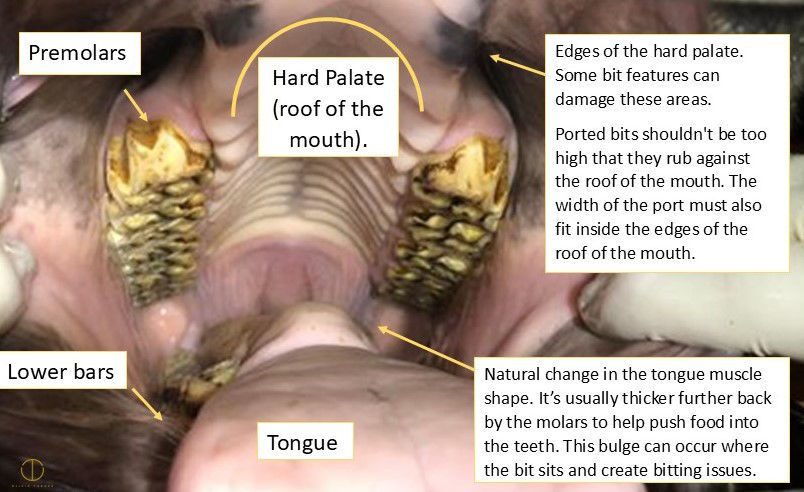
While mouth conformation is important, horses don’t always prefer bits that match their mouth conformation exactly. For example, not all horses with very fleshy mouths and little space prefer thinner mouthpieces that don’t take up as much room, some prefer thicker mouthpieces which distribute the pressure over a wider surface area. So when choosing a bit, we must take into account the individual preferences of the horse.
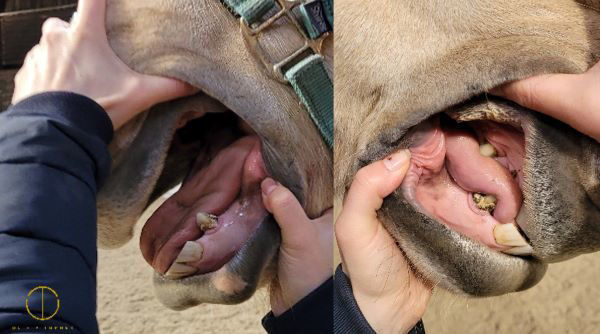
This horse has very fleshy inner lips, a large tongue and not a lot of room for a bit.
He preferred a single jointed mouthpiece over a lozenge due to its simplicity and at a thickness of 16mm.
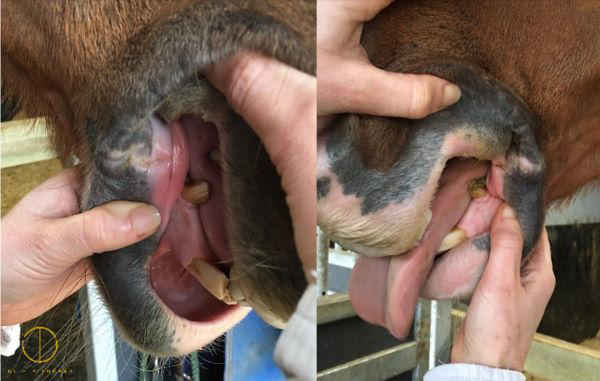
Check the mouth for injuries or bit damage.
This horse has scarring and cuts on the inside of its fleshy lips where a loose ring bit was too small.
Check for wear and tear on your current bit, especially plastic or synthetic ones that can be chewed! This prevents damage to the inside of the mouth and stops breakages happening when you’re riding.
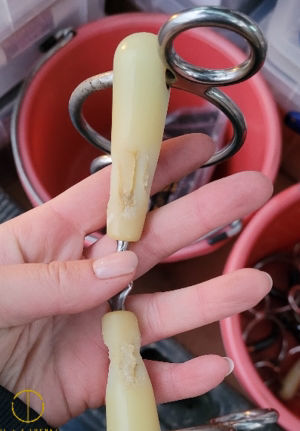
This plastic bit has been chewed, creating very sharp edges that cut the horses tongue and bars.
Sometimes it’s not the bit causing bitting issues, it can be their teeth! This article looks at the importance of regular dental care and ties in nicely with bitting: https://www.feedmark.eu/the-importance-of-regular-dental-care
Lorinery Science: How Bits Work
The pressure created by a bit encourages the horse to offer the behaviour or movement required by the rider. The rider applies a certain amount of force through the reins and this travels through to the bit which can then act on different areas of the mouth and jaw including the lips, bars, tongue, hard palate, chin, and poll depending on the type of bit being used.
As the rider pulls on the reins, the bit will change position. All bits will rotate, slide backwards along the tongue and upwards towards the rider's hands when pressure is applied. If the rein attachment lies below the mouthpiece and the cheekpiece attachment is on a separate ring, then leverage (poll pressure) is created.
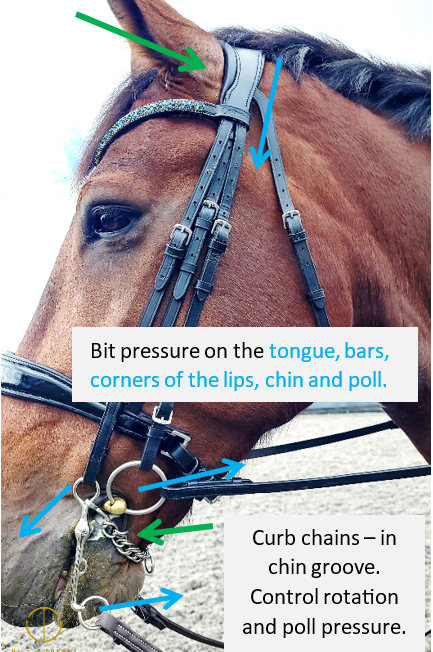
Double bridle. The weymouth will produce poll pressure and is used with a curb chain.
Cheek Types and Their Function
Here are the main categories of cheek types, how they work and how they can be beneficial for a horse.
Loose rings - Create movement, softness, reduce pressure in the corners of the lips, release rein pressure quickly. Pulls back towards the rider. Allow a small gap either side of the lips between the bit ring to prevent pinching.
Fixed cheeks – Offer stability for the horse and allow the rider to be more direct and supportive with the contact. It makes the aids feel more ‘black and white’ as there isn’t any sliding of the cheek. Pulls back towards rider. Cheek should sit flush against the lips as it’s designed to offer a stable, consistent feeling. Variants include: eggbutts, D-rings, full cheeks, fulmers and hanging cheeks/ bauchers.
Fixed cheek levers – Encourage a head down action and create a strong ‘box’ for the horse to be in. These offer varying levels of strength and control. Variants include: kimblewicks, pelhams, elevators, jumpers and running gags.
Loose ring levers – Have a lifting effect on the head and squeeze up into the corners of the lips whilst pulling the head down and back. Variants include: wilkies / bevals, universals / 2 ½ rings, 3 ring gags / Dutch gags, running gags.

Two examples of bits which can create leverage if the rein is used on the lower rings.
Mouthpiece Types and Their Function
Single Joints - Squeezes bars and creates a point which can be sharp in the mouth. Tweezer effect on the edges of the tongue and bars. Can create a lighter contact due to the sideways squeeze encouraging the horse to lift above it. Can be good for young horses or horses that fiddle because there is less going on in the mouth.
Double Jointed (lozenges and plate links) – Give more room for the tongue, 2 or 3 main pressure points on the tongue (loops connecting to the feature: lozenge or plate). Pressure is focussed on centre of the tongue which reduces the sideways squeeze. Plate edges can dig into the tongue creating a sharper contact area than a rounded lozenge.
Waterfords – Lots of little pressure points on the tongue and bars that are very movable and can adapt to the shape of the mouth. This makes it harder for a horse to grab hold and set on it and can also offer a quick release in pressure. This can be a very strong mouthpiece. Always look for a lip shelf to prevent the joints pinching in the corners of the lips.
Rollers – These create little pressure points and mean the mouthpiece rolls along the tongue. The rolling action can reduce the feel of the squeeze which can create lightness and helps prevent horses from becoming heavy or leaning. Moveable parts can encourage chomping or fiddling and there’s the possibility of pinching.
Solid mouthpieces – Can be straight, curved or ported. Distributes pressure across the mouth and ports will reduce pressure on the tongue but do apply that pressure on the bars of the mouth. Can be quite restrictive and apply a lot of pressure depending on the design. Can offer horses a stable mouthpiece that doesn’t move or squeeze against them.
Barrel mouthpieces – Similar to a solid mouthpiece but with a centre barrel that allows each arm to move independently. Can be ported or straight and offer varying degrees of squeeze depending on how moveable the arms are in relation to the barrel joint. A favourite for many horses as there a is little squeeze but more movement when compared to a solid mouthpiece.
Horse Comfort
Every horse is an individual who will prefer different mouthpiece types and levels of pressure. Their learning and training history is very relevant and will guide you on what type of bit you choose. Ask yourself “what does bit pressure mean to my horse?” and “does my horse understand the question?” Work out what gaps there are in the training and what your horse understands. Then ask what do you need the bit to do and how can it help encourage your horse to offer those behaviours? For example, you might need more lightness and softness, in which case you’d consider a lighter bit material like titanium and you could look for a soft, movable bit that encourages your horse to relax into your hand.
We’re asking the horse to perform for us, be willing riding partners and perform at their best. In most cases they have little choice over what pieces of tack we use, so it’s our responsibility to ensure they are comfortable and happy with what they’re in and the pressure it applies. Working out what your horse is happy with is the key, for if there is discomfort, there is resistance, and this will prevent you from having a soft connection where your horse is light and responsive. A happy, comfortable horse is able to perform at its best.
Common signs that could indicate your horse is unhappy with the bit are:
- Head tossing or a sudden reaction when rein pressure is applied. This can be because the bit is pinching somewhere inside the mouth or because there is dental pain.
- Tongue evasions such as: sucking the tongue back and opening the mouth, poking the tongue out the side of the mouth or over the bit.
- Tugging the bit out of your hands or ‘nose nudging’ their mouth away from your hands when you take up a contact.
- Excessive salivation where the horse isn’t swallowing it.
- High head carriage above the bit.
- Offering an overbent frame to avoid bit pressure and tuck behind it.
- Clear signs of irritation when the bit is put in such as constant chewing, fiddling and fussing.
- Flapping the lips when ridden can indicate bodily tension and therefore resistance to your aids.
- Head tilting and straightness issues.
This is not an exhaustive list and some of these issues will have other root causes such as dental pain, musculoskeletal pain, saddle fit issues, etc. It’s important to look at any bitting issues holistically to ensure every aspect of the horse’s ridden performance is investigated thoroughly.
If you want to change your horse’s bit but are unsure where to go, seek advice from a qualified bitting professional. You can find them on the Equine Fitters Directory website: https://www.equinefittersdirectory.org/

Written by Olivia Turner, BSc Hons.
Animal Behaviour Consultant & Equine Bitting Specialist.
Based in East Anglia and covering the whole of the UK.
Olivia is a Freeman with The Worshipful Company of Loriners, a registered fitter with The Equine Fitters Directory and a BETA Council member.












